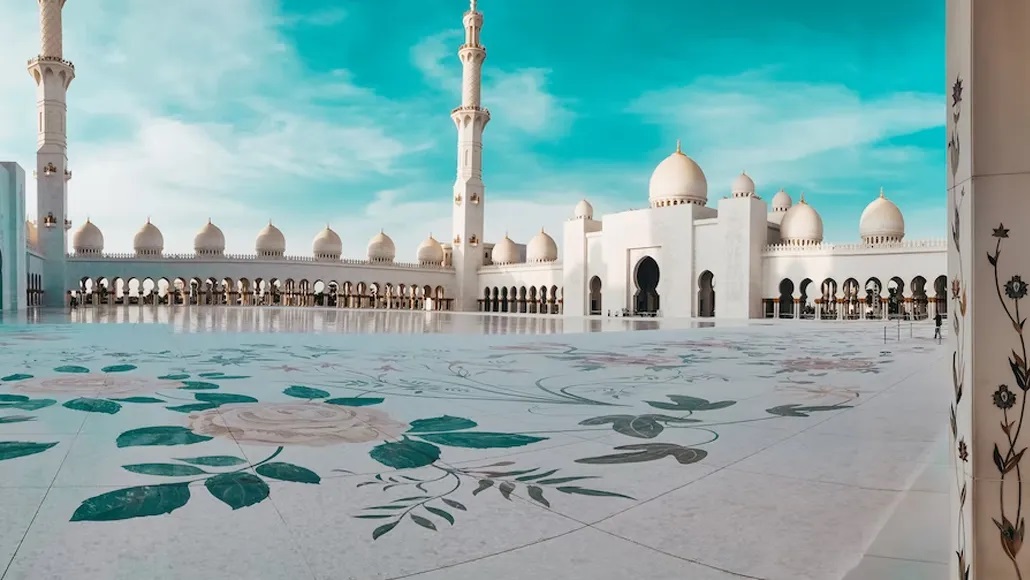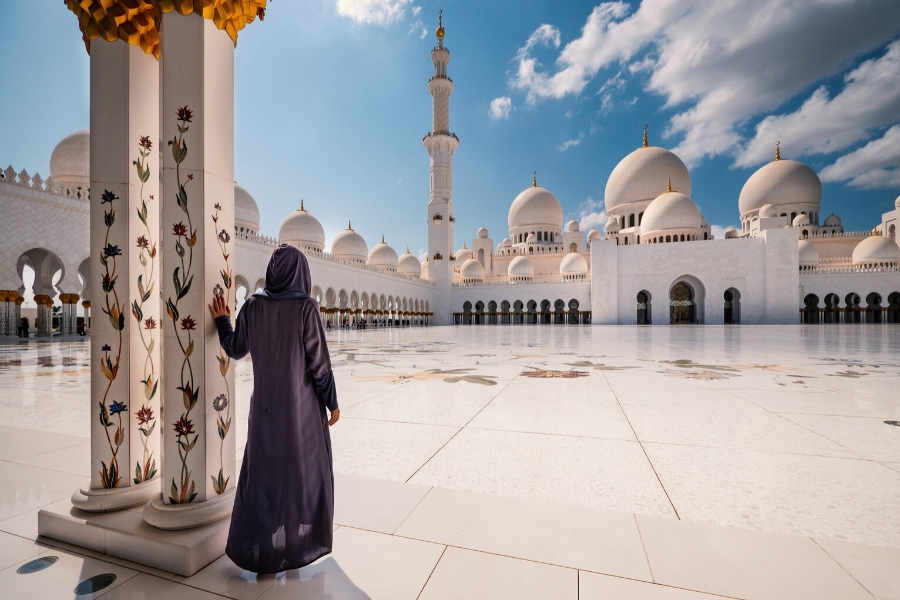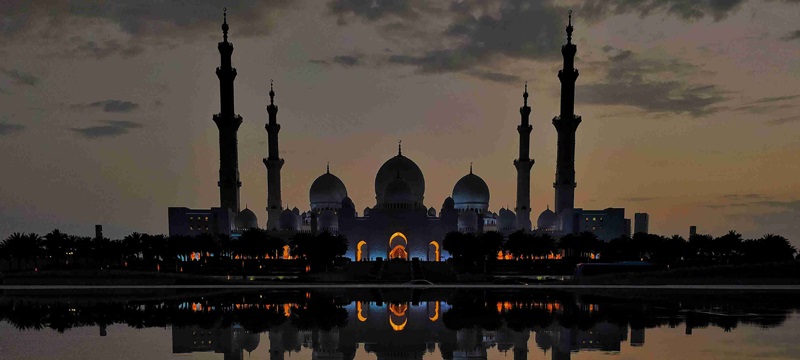


The beauty of the mosque is disarmingly captivating in terms of splendor, with its significance as a highly authentic cultural landmark symbolizing the rich history and heritage of the Emirates.
The building's main prayer hall and two other halls cumulatively accommodate more than 10,000 devotees at a time. The magnum opus was built at a cost of 2.5 billion AED (or 1 billion dollars), with construction spanning 12 years starting in 1996.
Every aspect of the mosque is world-class; semi-valuable stones like amethyst, lapis lazuli, and jasper make a spectacular presence in every point. The mosque’s sophisticated design holds any spectator in awe with its 82 vaults, sky-puncturing minarets, and snow-like floor gleaming in shining white marble.
Exclusive floral patterns in mother of pearls on the walls, Faustig brand light fixtures brim with twinkling Swarovski crystals, while 24-carat gold gleams on the roof. The mighty Chandlier on the main hall stands out with its suspension from a height of 15 meters.
There are severe restrictions on videography and photography inside the premises. No entry is allowed inside the main courtyard and several pillar areas. However, dedicated photo spots are there, even if they are a bit crowded.
Make good use of the guided tours to know in depth about the grand mosque, and even intricate details including the gold-leaf calligraphy that envelops the hollows of the 82 domes. As for the 96 columns in the main prayer hall, they are inlaid with mother of pearl and marble.
So, clear updates on Abu Dhabi’s Sheikh Zayed Mosque entry rules for non-Muslims plus what to do and what not will give an immersive experience of the visit to the Grand Mosque.

Sheikh Zayed Grand Mosque attracts millions of visitors every year and is revered as one of the most popular landmarks in the world.
Beyond the overwhelming architecture, its open-door policy attracts visitors from around the world. They want to watch its beauty and understand the Emirate’s culture of openness. The mosque offers guided cultural visits in both English and Arabic.
The Grand Mosque is open to visitors from Saturday to Thursday between 09:00 and 22:00 and on Friday from 16.30 to 22:00.
People of all faiths are allowed in the mosque. But Abu Dhabi’s Sheikh Zayed Mosque entry rules for non-Muslims have to be followed in toto. One is the specific dress code for the visitors.

The visitors have to abide by the suggested dress code. Abayas are recommended for ladies, and for men, long pants will suffice. The clothing regulation is very strict and applies to Abu Dhabi’s Sheikh Zayed Mosque entry rules for non-Muslims. It is meant for ensuring that all visitors, no matter their background, status, or experience, have to respect the holiness of the site, and they must be equals.
The abaya is a conventional, dark shroud that ladies wear while visiting the mosque. The clothing represents humility and adherence to the social customs of the UAE. It also allows the wearer to mingle well with the customs.
The best abayas flaunt nice designs, subtle embroidery, lace details, and modern cuts, boosting the appeal. In case a visitor does not have an abaya, the mosque has the facility to offer one on rent at the entry.
Ladies should wear clothing that covers the whole body, including the head, arms, and legs. The mosque will loan abayas and headscarves to ladies who might not have the same with them.
However, visitors knowing Abu Dhabi’s Sheikh Zayed Mosque entry rules for non-Muslims are expected to bring their own for a perfect fit. The garments must have long sleeves, and full-length skirts or jeans are required, and clothing should not be tight-fitting or too transparent.
One more objective with the clothing standard is to achieve a uniform look for guests based on equity and solidarity as values that the mosque addresses.
The headscarf, or hijab, is an essential component of the clothing code for ladies at the Grand Mosque. Ladies must cover their hair fully in compliance with the custom there. The hijab must be worn in a manner that completely hides the hair with no strands seen outside.
It is good to have scarves made of lightweight, breathable materials, guaranteeing comfort even in a warm environment.
Visitors are advised to carry sunglasses as the walls and the ground are so white and reflective, and a sunny day may make it hard to keep the eyes open.
Given the fact that the Abaya service area will be usually crowded receiving and returning the robe. To save time, it is good to come prepared with appropriate clothing such as loose pants or a full skirt covering legs with a full hand top and a thick scarf covering the head and neck so that you can enter the holy place directly.

There is an underground mall that helps to access the mosque from inside instead of crossing the main road. The mall has excellent food and clothing outlets that support buying the needed clothing and get something to eat before or after the visit too.
Try to wear sandals or flip-flops rather than shoes for faster entry. During Ramadan, Fridays, and other Islamic festivals, the visiting hours are subject to change. So, checking the website for updated information is very important.
Ideally, it is best to visit the mosque just before sunset so that you will see the mosque in all glory both in daylight and nightlights.

For non-Muslims, a visit to the Grand Mosque on a Friday can face challenges of limited time availability. The visiting times on Friday are 09:00 am to 12:00 pm (last admission at 11:30 am), then 3:00 pm. to 10:00 pm, where the last entry is at 09:30 pm.
So, non-Muslim visitors, if they can choose some other day other than Friday, it helps. The mosque opens late after the Friday prayers, and people come to pray at sunset and in the evening on Fridays rather than other days.
Covering the arms and legs is an essential part of the clothing standard. Ladies wear long-sleeved tops that extend to the ankles, matched with full-length jeans or skirts that stretch at the lower legs. This applies to all, irrespective of the climate, making it imperative to pick materials for clothing that are highly functional.
Free-fitting tops are comfortable and align well with the rules of the mosque. Make sure the skirts and pants are of breathable textures so that they stay cool.
Other than the conventional abaya, the best use of kaftans, maxi dresses, and layered outfits also conforms to the social custom of the holy site.
Among them, kaftans are ideal for women who want to combine comfort with cultural sensitivity. These long, loose-fitting garments come in a range of styles, including intricately patterned pieces, ensuring full coverage.
Kaftans carry beautiful embroidery, or prints, making them modest and elegant too. Its flowing silhouette ensures cool and comfort, and the loose fit eases movement when exploring the mosque’s stunning architecture.
Other dresses for females for the mosque visit are Maxis and layered outfits. In the latter, you can have a base layer of protracted-sleeved shirt or pullover with a matching sleeveless, tunic, or a long sweatshirt. This blend adds flexibility and helps to change dresses easily during the day.
For the base stockings, leggings, or wide-leg pants beneath a long skirt will work. A light-weight cloak or wrap will cover the top and shoulders pretty well with a chic look too.